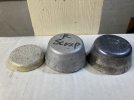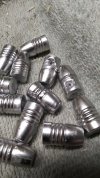Randominator
New Member
I was at my local salvage yard this week picking up some wheel weights. The guy said "I've got some pure lead if you're interested". Same price as the wheel weights, so I bought it. 40 lbs total in two large bricks and two small round weights. I brought it home and melted it down and poured it into ingots. The first thing I noticed was it took a while for the ingot to form into a solid, it had a reach a lower temperature before it would solidify. The next was when I finished, my 40 lbs of "lead" made over 65 one pound ingots. Each of the ingots barely weighs half a pound. What I was told was pure lead is on the left, straight wheel weight in the middle, and linotype on the right.

I'm thinking I may have bought pure tin.
Thoughts?

I'm thinking I may have bought pure tin.
Thoughts?


